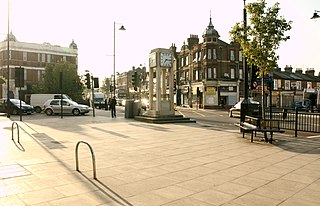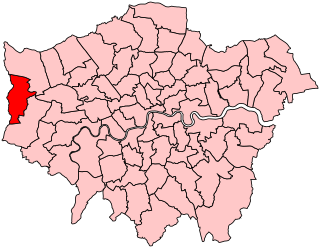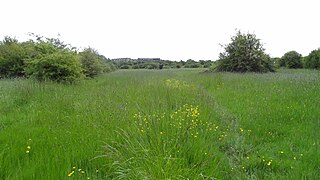
Elthorne was a hundred (ancient subdivision) of the historic county of Middlesex, England.

Elthorne was a hundred (ancient subdivision) of the historic county of Middlesex, England.
The name is a standard contraction in Old English of El(ɘ's) thorn – El likely being a man, perhaps one of the eorls (earls) in the same way as Spelthorne Hundred, adjacent, and the thorn would accurately reflect that most of the land, like Hounslow Heath of today, until and unless manually cleared was covered or underlain as it naturally is here with hawthorns, blackthorns and brambles. The most distinctive of these is the sometimes tree-height genus, the hawthorn, which is in warm months heavy with small white flowers and is endemic to the local gravel-rich soil and banks of rivers across all England save for the north and south-west, where its larger type also extends to. [1] [2] Blackthorns are alongside hawthorns the ancient underlayer of the local Ten Acre Wood, an oak plantation. [3] Antiquaries have suggested a meeting-point tree, in the same way as Ossulstone was a meeting point, however, in the same way as "broom" and "gorse" are used whether the noun refers to single thorn tree is unascertainable.
It was a north-west portion having these parishes: [4] [5]
It thus closely corresponded to the present London Borough of Hillingdon, plus the western half of the London Borough of Ealing. The eastern third of Ealing is mainly Ealing and Acton which lay in Ossulstone Hundred.

Major roads and housing estates have simplified the borders of localities — as shown on each local street name sign in these boroughs. The complexity of many old parish borders of Elthorne hundred has been reduced. This is seen in the modern borders of the local Church of England ecclesiastical parishes, radically simplified. As to the smallest of old parishes most boundaries have greatly changed particularly Ickenham which has shifted west. Local councils have not gone so far as to redefine street signs on the basis of equal-electorate electoral wards. They locally take heed of a fusion of long history, wards and numbered postal districts. [11]

Hanwell is a town in the London Borough of Ealing. It is about 1.5 miles (2.4 km) west of Ealing Broadway and had a population of 28,768 as of 2011. It is the westernmost location of the London post town.

Harmondsworth is a village in the London Borough of Hillingdon in the county of Greater London with a short border to the south onto London Heathrow Airport and close to the Berkshire county border. The village has no railway stations, but adjoins the M4 motorway and the A4 road. Harmondsworth was in the historic county of Middlesex until 1965. It is an ancient parish that once included the large hamlets of Heathrow, Longford and Sipson. Longford and Sipson have modern signposts and facilities as separate villages, remaining to a degree interdependent such as for schooling. The Great Barn and parish church are medieval buildings in the village. The largest proportion of land in commercial use is related to air transport and hospitality. The village includes public parkland with footpaths and abuts the River Colne and biodiverse land in its Regional Park to the west, once the grazing meadows and woodlands used for hogs of Colnbrook.

Northwood is an area in the London Borough of Hillingdon, located 14.5 miles (23.3 km) north-west of Charing Cross. Northwood was part of the ancient parish of Ruislip, Middlesex. The area was situated on the historic Middlesex boundary with Hertfordshire, and since being incorporated into Greater London in 1965, has been on the Greater London boundary with that county.

Longford is a suburban village in the London borough of Hillingdon, England. It is immediately northwest of London Heathrow Airport, which is in the same borough. It is the westernmost settlement in Greater London, very close to the borders of both Berkshire and Surrey.

Uxbridge was a seat returning one Member of Parliament (MP) of the House of Commons of the UK Parliament from 1885 to 2010. Its MPs elected were: Conservative Party candidates for 107 years and Labour Party candidates for 18 years. The closing 40 years of the seat's history saw Conservative victory — in 1997 on a very marginal majority in relative terms.

Uxbridge was a local government district in north west Middlesex, England, from 1849 to 1965, seated in the town of Uxbridge.

Gore was a hundred of the historic county of Middlesex, England.

Uxbridge Rural District was, from 1894 to 1929, a local government district in Middlesex, England.

Mellow Lane School was a comprehensive school, located in Hayes, in the London Borough of Hillingdon, Middlesex. It closed in 2011 and reopened in August of that year, as Hewens College.

St Mary the Virgin is a 13th-century Anglican parish church in Northolt, London Borough of Ealing. It is on a slope shared with Belvue Park, the site of a 15th-century manor house — both overlooked the old village of Northolt. It is one of London's smallest churches, its nave measuring 15 yards (14 m) by 8 yards (7.3 m). The church was built around 1290 and was expanded over the centuries, with the chancel being added in 1521, the spired bell tower in the 16th century, and a gallery at the west end of the church in 1703. Twin buttresses were erected against the west wall around 1718 to alleviate concerns that the church could slip down the hill. The internal beams are original and the bells date from the 17th century. The church was constructed from a variety of materials; the nave incorporates clunch, flint and ironstone, and the mouldings of the doors and windows are made from Reigate Stone.
John Pritchett was an English churchman, bishop of Gloucester from 1672.

RAF South Ruislip, also known as South Ruislip Air Station, was a non-flying Air Force station located in South Ruislip near London, England. Located close to RAF Northolt, the station was used by the United States Air Force's Third Air Force from 1949 until 1972, when the headquarters were moved to RAF Mildenhall.

Dormers Wells or Dormer's Wells is an urban community or neighbourhood in west London, England consisting of a grid of mostly semi-detached or terraced houses with gardens and small parks: in the London Borough of Ealing, and the Southall post town area.

Brentford railway station opened on 1 May 1860 on the Brentford Branch Line which had opened in 1859 from Southall to Brentford Dock. It stood immediately north of Brentford High Street on the embankment leading to the viaduct into the dock. The station closed on 22 March 1915 as a wartime economy measure, re-opened on 12 April 1920 and closed permanently on 4 May 1942. The station was demolished in 1957.
Alec Reed Academy is a mixed all-through school and sixth form located in the Northolt area of the London Borough of Ealing, England. The school operates nursery, primary, secondary and sixth form departments for pupils aged 3 to 19.

Islip Manor Meadows is a 23.75 hectare Local Nature Reserve and Site of Metropolitan Importance for Nature Conservation in Northolt in the London Borough of Ealing. It is owned and managed by Ealing Council.

Hillingdon Civic Centre is a municipal building in the High Street, Uxbridge. The civic centre, which is the headquarters of Hillingdon London Borough Council, is a Grade II listed building.

Benjamin Lethieullier (1729-1797), was a British politician who sat in the House of Commons between 1768 and 1797.

Southall Town Hall is a municipal building in High Street, Southall, London. It has been designated a local heritage asset.

Harrow Civic Centre is a municipal building in Station Road, Harrow, London. It is the headquarters of Harrow London Borough Council.